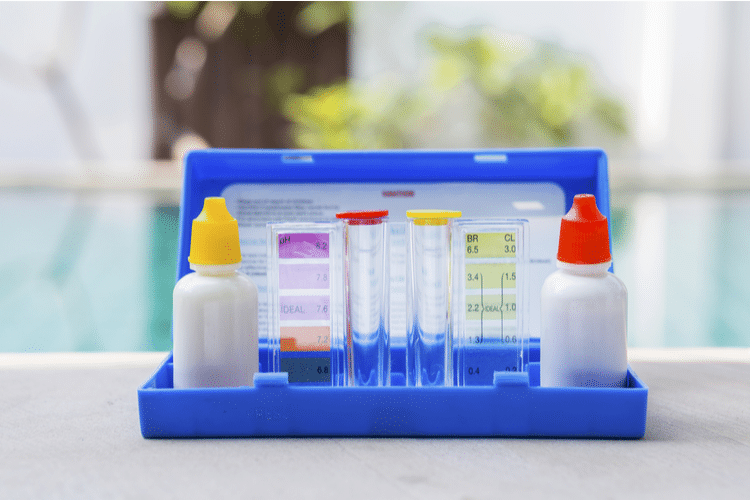What is Arsenic?
Arsenic is a naturally occurring element that can be found in both organic and inorganic compounds. Organic arsenic compounds are harmless, but when paired with inorganic substances, the metal becomes dangerous.

Organic arsenic is present in fish and shellfish and doesn’t cause adverse health effects. Inorganic arsenic compounds are used to make glass, paper, certain textiles, ammunition, pesticides, and pharmaceuticals.
Inorganic arsenic compounds can contaminate soil and groundwater due to the improper disposal of hazardous industrial waste. Water contaminated by pesticides or pharmaceutical waste can have high levels of arsenic.
How to Remove Arsenic From Water
Reverse osmosis, distillation, adsorptive media, and anion exchange are the 4 most effective ways to remove arsenic from water:
1. Reverse Osmosis
Reverse osmosis removes arsenic by pushing the water through a semi-permeable 0.0001-micron membrane, which prevents the arsenic molecules from passing through. It is the most inexpensive way to remove arsenic from water.
Refer to our article on best arsenic water filters for product recommendations.
2. Distillation
Distillation is a process that boils pollutants such as arsenic out of water. When water is distilled, it is boiled to a steam or vapor state, then passed through coils to cool it off. In its gas state, the water can no longer hold impurities such as arsenic.
3. Adsorptive Media
Adsorptive media filters that feature activated alumina or iron-based sorbents are also an effective way to remove arsenic from your water. In addition to arsenic, they’re also known to remove other dangerous heavy metals and chemicals such as uranium, by adsorption through porous and granular aluminum- or iron-based media.
Adsorptive media is most commonly used in industrial-level water processing since they’re ideal for treating large water beds. But despite the big strides made in water filtration technology in recent years, finding an adsorptive media filter suitable for household use can be difficult.
4. Anion Exchange
The anion exchange process is similar to the ion exchange process water softeners employ. It utilizes an ion resin bed to remove ionic contaminants. Unlike ion exchange, which removes minerals like calcium and magnesium (cations), anion exchange can also remove negatively charged ions like arsenic and nitrate (anions).
The ion resin catches and encloses arsenic particles in the water, which is then replaced with sodium ion.
Anion exchange devices are only effective for low TDS water and can’t be used if the arsenic level exceeds 100ppb.
Cost of Removing Arsenic From Water
It costs between $100 – $3,000 to remove arsenic from water, depending on the arsenic removal method.
- Distillation: $100-$150
- Reverse osmosis: $250-$1,000
- Point-of-use filter with adsorptive media: $150-$400
- Point-of-entry filter with adsorptive media: $1,500-$3,000
- Anion exchange resin: $300-$500 per one cubic foot
How to Test for Arsenic in Well Water
If you own a private well, you should have your water tested at least twice a year. However, if you suspect that there’s arsenic in your water, you can deviate from your annual water-testing schedule and test immediately.
Since it’s an odorless and tasteless contaminant, it’s difficult to detect arsenic through the senses. This means that you need to either test with professional labs or use water testing kits.
1. Water Testing Kits
A home water testing kit that’s specifically designed to test for arsenic is the easiest way to determine the arsenic levels in your water.

Just fill a glass with water and place a section of the testing strip inside. Leave it inside the water in line with the specifications of the manufacturer. After 10 minutes, a color chart will indicate the amount of arsenic in your water.
2. Private Labs
A more reliable way to test well water is by contacting the local health department or sending a water sample to a certified lab. They will be able to effectively test and determine the arsenic levels in your water.

Is Arsenic More Likely to Be Found in Well Water?
A study by the Columbia health researchers shows that arsenic contamination can occur in well water as well as city water, but is more likely in well water. If the soil, bedrock, and groundwater of the region naturally contain arsenic, the water in the wells in that area can be contaminated. This is especially true for wells that are drilled into bedrocks in arsenic-rich areas.
Health Effects of Drinking Arsenic Contaminated Water
Toxic exposure to arsenic can cause dire and chronic health problems. The EPA sets the arsenic standard for drinking water at 10 ppb (parts per billion), and any level beyond that can cause either short-term or long-term effects.
Short-term problems:
- Neurological problems (numbness and burning in some regions of the body)
- Nausea and vomiting
- Fatigue
- Cardiovascular problems
- Decreased white and red blood cell production
Long-term problems:
- Thickening of the skin
- Skin discoloration
- Persistent sore throat
- Growths on feet and hands
- Digestive problems
- Prostate and kidney cancer
- Skin darkening
It is important to note that long-term exposure will affect the skin first. Also, symptoms can lie dormant before you start experiencing their effects.